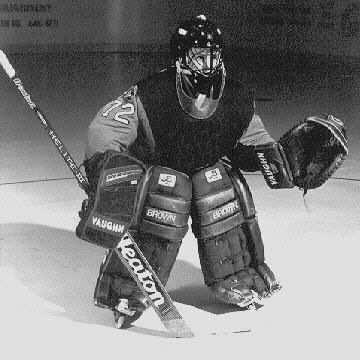Goaltender is quite possibly the most difficult position to play in roller hockey. Faced with a large number of shots, a goaltender is the one player who has a direct impact on the outcome of each game since he has the final opportunity to stop the puck from entering the net. The goaltenders role is to defend the net. He won't stop everything but must try and maximize his potential to stop everything. A goaltender's potential increases when he is in proper position. Positional play is the most important aspect of goaltending.
Unlike other members of a roller hockey team who can rest between shifts, a goaltender is usually on the playing surface for the entire game. He must be able to maintain his workload over a 40 to 50 minute game in a highly efficient manner, so stamina is crucial. A goaltender must be one of the best conditioned players on the team, as well as an efficient and powerful skater. The ideal goaltender is also physically strong and able to work at top speed while wearing about 25 pounds of protective equipment. A goaltender must have good balance and reflexes so he can react quickly to high speed shots which can unpredictably change direction through deflection. He must have excellent eyesight, combining depth perception, peripheral vision, and the ability to focus quickly. He must be extremely agile so he can move quickly near the net and must also be flexible so he can stretch and contort himself in any way required to block or trap the puck. Although goaltending equipment continues to become lighter and more protective than just a few years ago, the lightness has been obtained through the use of plastic, nylon and foam. This combination of materials hinders the skin's ability to breathe and creates body heat buildup and water loss. This loss of water results in an easily fatigued goaltender, so it is very important that a goaltender drinks plenty of water.
 A sound basis in
fundamental skills is the only way a goaltender can ensure that he will be prepared for
the quick pace of roller hockey. Fundamentals are developed through constant repetition
during practice until they become second nature. Practice also develops the confidence and
mental toughness required of this position. Goaltenders should be included in all practice
planning, as they need instruction just like any other player on the team.
A sound basis in
fundamental skills is the only way a goaltender can ensure that he will be prepared for
the quick pace of roller hockey. Fundamentals are developed through constant repetition
during practice until they become second nature. Practice also develops the confidence and
mental toughness required of this position. Goaltenders should be included in all practice
planning, as they need instruction just like any other player on the team. Just as the forwards look to the defensemen for help; the defensemen look to the goaltender for help. The goaltender knows that the puck must stop with him. Roller hockey is a team game, but in the end, the greatest pressure is on one position, the goaltender, at ground zero.